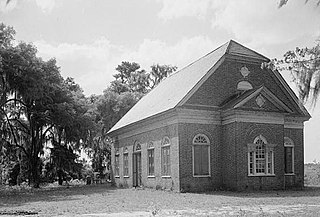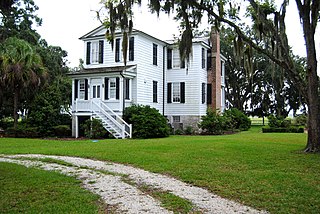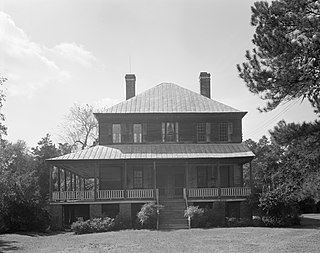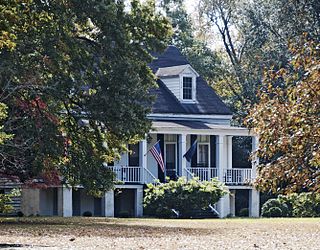
Huger is an unincorporated community in Berkeley County, South Carolina, United States. It is part of the Charleston–North Charleston–Summerville Metropolitan Statistical Area. The ZIP Code for Huger is 29450.

Middleburg Plantation is a historic colonial-era plantation on the Cooper River near Huger, South Carolina. The plantation house, built in 1697 by the French Huguenot Benjamin Simons, is probably the oldest standing wood-frame building in South Carolina, and is consequently an architecturally important example of period construction. It was declared a National Historic Landmark in 1970.

PompionHill Chapel is small "back parish" church near Huger, South Carolina. Built in 1763, it is a virtually unaltered example of a brick Georgian parish church, retaining interior and exterior finishes. It was declared a National Historic Landmark in 1970.

Mulberry Plantation is a historic plantation property in rural Berkeley County, South Carolina. Located between Moncks Corner and Charleston, this property was developed in 1714 by Thomas Broughton, who became the Royal governor of South Carolina, and is one of the oldest plantation homes in the United States. Its rice fields, dikes and canals were well-preserved into the 20th century. The plantation house and ten surrounding acres were declared a National Historic Landmark in 1963.

Loch Dhu is a house in northwestern Berkeley County, South Carolina about 7 mi (11 km) east of Eutawville, South Carolina. It was built around 1812–1816. It is located close to Lake Marion about 1.3 miles (2.1 km) north of South Carolina Route 6 on Loch Dhu Lane. It was named to the National Register of Historic Places on July 13, 1977.

Tombee Plantation is a historic plantation house located on Saint Helena Island near Frogmore, Beaufort County, South Carolina. It was built about 1790–1800, and is two-story, T-shaped frame dwelling. It is sheathed in clapboard and has a gable roof. It features a single-story front portico with four square columns and a two-story balustraded rear porch with six square columns on each floor. Along with Seaside Plantation, it is one of the few surviving antebellum plantation houses remaining on St. Helena Island. The Tombee Plantation property was divided into tracts during the days of the "Port Royal Experiment" in 1862. It remained in the hands of descendants of freed slaves until 1971.
Seaside Plantation, also known as the Edgar Fripp Plantation, is a historic plantation house located on Saint Helena Island near Beaufort, Beaufort County, South Carolina. It was built about 1795 to 1810, and is a two-story, frame dwelling in a transitional Georgian / Federal style. It features one-story hip roofed portico. Seaside was one of the plantations participating in the Port Royal Experiment and had as its labor superintendent Charles Pickard Ware (1840–1921). Charlotte Forten Grimké (1837-1914) also resided at Seaside Plantation. Along with Tombee Plantation, Seaside is one of only a few remaining antebellum plantation houses on St. Helena. Also on the property are the contributing original, brick-lined well, a clapboard shed, a large barn with clapboard siding and tin roof, and a round concrete and oyster shell silo.
Orange Grove Plantation is a historic plantation house and national historic district located on Saint Helena Island near Frogmore, Beaufort County, South Carolina. The district encompasses one contributing building and two contributing sites, and reflects the early-20th century influx of Northerners onto St. Helena Island. The plantation was first recorded in 1753 when Peter Perry purchased 473 acres. Perry owned 46 chattel slaves. The plantation house, built about 1800, was in poor condition when Henry L. Bowles (1866-1932), a U.S. Representative from Massachusetts, bought the property in 1928. He demolished it and built the present house in the same year. The property also includes the tabby ruin of the kitchen, built about 1800, and a tabby-walled cemetery containing three early-19th century graves of the Fripp and Perry families.

Sams Plantation Complex Tabby Ruins is a historic plantation complex and archaeological site located at Frogmore, Beaufort County, South Carolina. The site, possibly built upon and occupied well before 1783. It includes the ruins and/or archaeological remains of at least 12 tabby structures. They include the main plantation house, a rectangular enclosure consisting of tabby walls, a large tabby kitchen, and five tabby slave quarters. Also on the property were a variety of tabby dependencies including a barn/stable, a smoke house or blade house, a well/dairy house, and a well. The property also includes the Sams family cemetery and Episcopal chapel enclosed by high tabby walls. Other structures include possibly an overseer's house, a granary/mill, and a tabby cotton house. During and subsequent to the American Civil War the Sams Tabby Complex was occupied by freedman. Following the Civil War the plantation house was destroyed by hurricanes.

Lawson's Pond Plantation is a historic plantation house located near Cross, Berkeley County, South Carolina. It was built about 1823, and is a large two-story clapboard structure set upon high foundations. It has a hipped roof and features a one-story piazza along the front and left facades.

Lewisfield Plantation is a historic plantation house located near Moncks Corner, Berkeley County, South Carolina. It was built about 1774, and is a 2 1/2-half story clapboard dwelling. It is supported by a high brick foundation that encloses a raised basement. It has a five bay wide verandah supported by six slender Doric order columns. Records show over 100 slaves were held in bondage on the plantation as of 1835.

Otranto Plantation is a historic plantation house located in Hanahan, Berkeley County, South Carolina. It was built before 1778, and is a 1 1/2-half story, rectangular gable-roofed stuccoed brick dwelling. It has an attached colonnaded piazza, or porch, on three sides. Also on the property is a contributing small frame servants’ house.
Otranto Plantation Indigo Vats are historic indigo vats located near Goose Creek, Berkeley County, South Carolina. Indigo vats are where fermentation and settlement processes for production of indigo dyestuff were accomplished. Each vat measures approximately 14 feet square and has a stuccoed interior. The upper vat, known as the "steeper vat", was used for the fermentation of indigo plants with the liquor drawn through a small portal into the "beater vat" below. The liquor was agitated, allowed to settle, and the remaining sludge strained, molded into cakes, and dried. The Otranto Plantation Indigo Vats were relocated by the Verona Chemical Company, later Mobay Corporation, from Otranto Plantation to their present site in 1979 to save them from demolition. They are the only such structures know to be in existence in South Carolina.
Richmond Plantation, also known as Girl Scout Plantation, is a national historic district located near Cordesville, Berkeley County, South Carolina. It was built about 1927, and includes a manor house and outbuildings constructed as a hunting lodge for George A. Ellis, a prominent New York financier and co-founder of E. F. Hutton & Co.

William Robertson House, also known as Wampee Plantation Summer House, is a historic home located at Pinopolis, Berkeley County, South Carolina. It was built about 1844, and is a two-story, three-bay, frame I-House, sheathed in weatherboard. It features a hip roofed, one-story porch spanning the façade and wrapping around the right elevation. The house was one of the early planters' retreats in the pineland village of Pinopolis.
Cainhoy Historic District is a national historic district located near Huger, Berkeley County, South Carolina. It encompasses nine contributing buildings, which range in date from the mid-18th century through the early-20th century. They represent the development of the village from a ferry landing to a small but thriving river port. It was the site of America's first porcelain factory, established by John Bartlam in 1765. Each building is a vernacular specimen from its respective period, including the Federal style. Cainhoy's significance lies in its role as an early transportation link between inland Berkeley County and Charleston and in its fine collection of early buildings. In 1876, Cainhoy was the site of a political rally for Wade Hampton (1818-1902) which degenerated into a brawl between blacks and whites. Christened the "Cainhoy Massacre," the incident left seven men dead and sixteen wounded.

Oakland Plantation is a historic plantation house located near Fort Motte, Calhoun County, South Carolina. It was built about 1800, and is a 1+1⁄2-story clapboard house with two flanking wings set back from the façade. The house sits on a brick foundation and has an enclosed basement. It has a front porch, supported by six square columns. Oakland is still surrounded by farmland, and the house and one outbuilding, the original kitchen, are situated on a one-acre lot.

Seaside Plantation House, also known as Locksley Hall, is a historic plantation house located at Edisto Island, Colleton County, South Carolina. It was built about 1810, and is a 2+1⁄2-story, Federal style brick dwelling with a gable roof. The house is one room deep with a long porch across the southeast elevation and sits on a raised basement. The central portion of the house is stuccoed brick with frame additions on the first floor.
Richmond Hill Plantation Archeological Sites consists of five historic archaeological sites located near Murrells Inlet, Georgetown County, South Carolina. The Richmond Hill Plantation complex sites include remains of the planter's house, two possible overseers' houses, approximately 20 slave houses, a slave cemetery, a rice barn, and rice fields and dikes. The plantation house, overseers' houses, and slave houses were all burned by about 1930. Richmond Hill plantation was owned by Dr. John D. Magill, who was considered one of the least efficient planters in the area and the most brutal slaveowner among the Georgetown District rice planters.
Gravel Hill Plantation is a historic hunting plantation complex located at Garnett, Hampton County, South Carolina. It was built in 1910, and is the 20-acre core of a large hunting plantation that includes eleven historic buildings; nine of them were designed and built by the owner, Robert Palmer Huntington. The complex includes three residential buildings, a kitchen and dining facility, ice house, stables and ancillary service buildings. Also on the property are a corn crib and a tenant's house. It is a rare example of the Adirondack or Rustic Style in South Carolina.
















